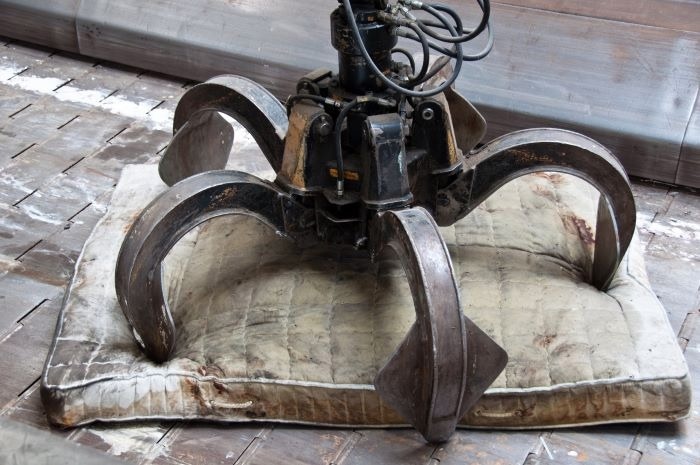Reviewed by Lexie CornerAug 19 2024
Researchers at Aarhus University have discovered a more effective way to recycle polyurethane foam from products like mattresses. This is fantastic news for the emerging sector, which wants to improve and lower the cost of its products by chemically recovering the original components of the material. These findings were published in Green Chemistry.
 Most old foam mattresses end up in landfills or incinerators. Now, research results from Aarhus University are bringing the industry closer to being able to recycle the polyurethane foam that these mattresses are made of. Image Credit: Colourbox
Most old foam mattresses end up in landfills or incinerators. Now, research results from Aarhus University are bringing the industry closer to being able to recycle the polyurethane foam that these mattresses are made of. Image Credit: Colourbox
Polyurethane (PUR) is a versatile plastic material used in a wide range of products, including mattresses, refrigerators, building insulation, shoes, vehicles, airplanes, wind turbine blades, and cables. While it could be considered a wonder material, it poses significant environmental and climate risks. Most PUR products are either incinerated or end up in landfills, which is problematic given that they are primarily derived from fossil fuels.
The scale of this issue is substantial. Nearly 26 million tons of PUR were sold globally in 2022, a figure expected to reach 31.3 million tons by 2030, with approximately 60 % of this total consisting of various forms of foam.
However, a small but growing sector is working on chemically depolymerizing PUR into its two main components, polyol and isocyanate, with the goal of recycling these components as raw materials for new PUR products. Despite these efforts, significant challenges remain. Separating and purifying these components is expensive, making it difficult for recycled materials to compete with "virgin" materials.
Breaking Down and Separating in One Go
The research team at Aarhus University presents a brilliant solution. They build on the existing industry practice of breaking down PUR foam with acid, a process known as acidolysis. However, unlike current methods that do not separate the broken-down PUR into its primary components, polyol and isocyanate—resulting in a mixture that cannot be directly recycled—the AU researchers have developed a method to achieve both breakdown and separation simultaneously.
The researchers heat flexible PUR foam to 220 °C in a reactor containing succinic acid. After the breakdown process, they use a filter to separate the components: polyols pass through the filter, while the other substance is trapped. The polyols that are collected can be reused to produce new polyurethane, as they retain a quality comparable to virgin polyol. The solid portion that is filtered out undergoes a simple hydrolysis process, converting it into a diamine, which can then be used to produce isocyanates and, ultimately, new PUR.
By employing this method, the researchers can extract two distinct fractions—diamines and polyols—from flexible PUR foam, such as that used in mattresses, and recover up to 82 % of the original material by weight.
Enormous Potential in the Industry
The method is easy to scale up.
Steffan Kvist Kristensen, Study Author and Assistant Professor, Interdisciplinary Nanoscience Center (iNANO), Aarhus University
He sees huge possibilities for recovering PUR foam waste in industries that utilize it as a raw material (slabstock).
Kristensen added, “But the prospect of also handling PUR waste from consumers requires further development.”
... But There is a Long Way to Go to a Circular Economy
Manufacturers in the PUR business utilize distinct formulas to produce certain material qualities in their products.
As a result, a number of problems must be addressed before a real economy in recycling polyurethane can be realized:
- Waste sorting
- Logistics
- Sorting PUR into types
Depolymerization is consequently just a minor component of the solution.
Not Just Flexible Foam
AU researchers have also explored the effects of acidolysis and hydrolysis on regenerated PUR foam and rigid PUR foam, and their method has proven effective for both types. However, the path to a circular economy remains challenging.
Rigid PUR foam, commonly used as insulation, is still in the early stages of being converted into valuable raw materials. The researchers are currently testing their method on additional polyurethane materials to assess their recyclability. They are also investigating ways to reuse the dicarboxylic acid employed in the process. Moreover, they aim to use the recycled materials to create new products, demonstrating that this technology can support a circular economy.
The study was funded by Innovation Fund Denmark, the Carlsberg Foundation, the Danish National Research Foundation, and the Novo Nordisk Foundation.
Journal Reference:
Bech, T. B., et. al. (2024) Chemical separation of polyurethane via acidolysis – combining acidolysis with hydrolysis for valorisation of aromatic amines. Green Chemistry. doi.org/10.1039/D4GC00819G